






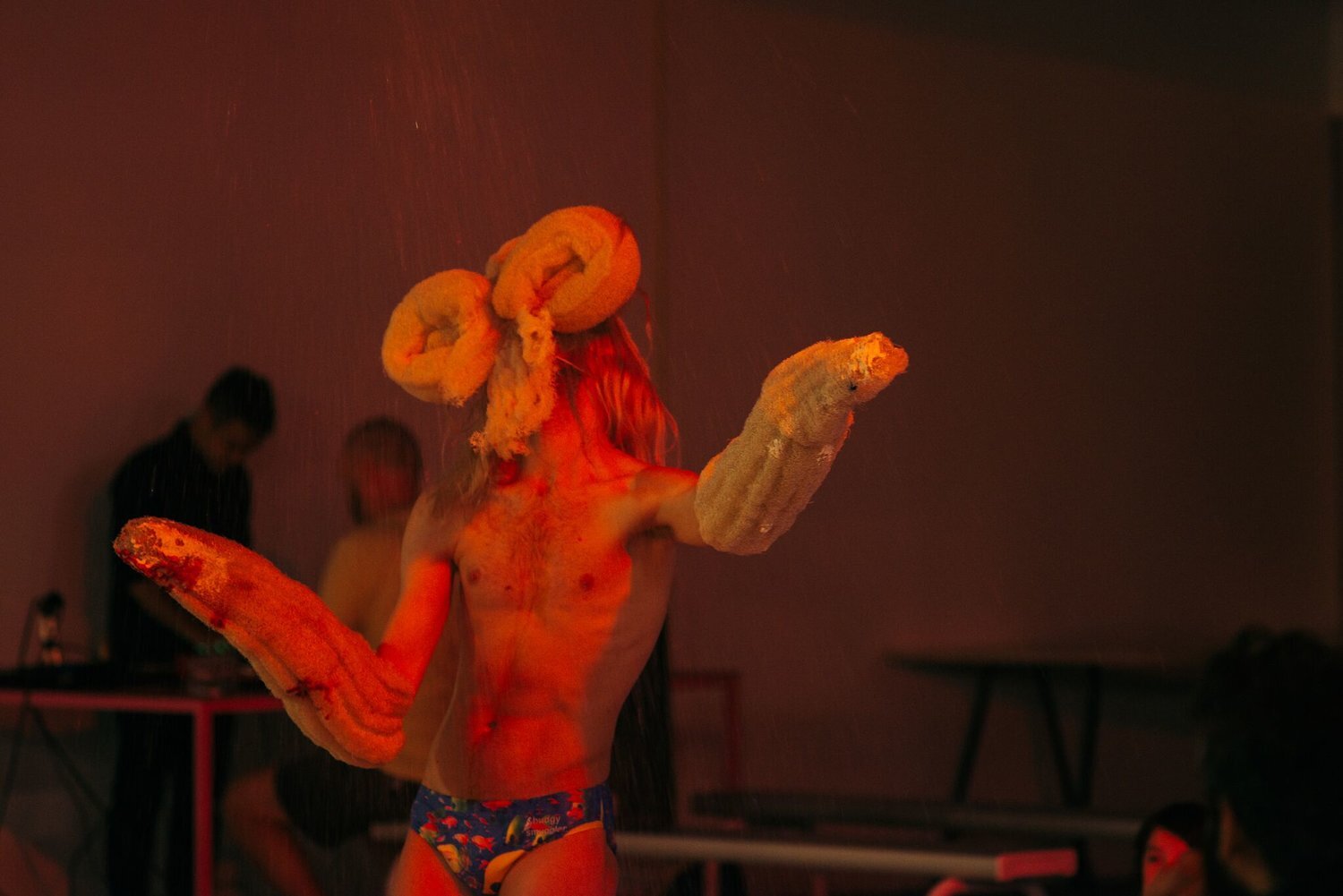
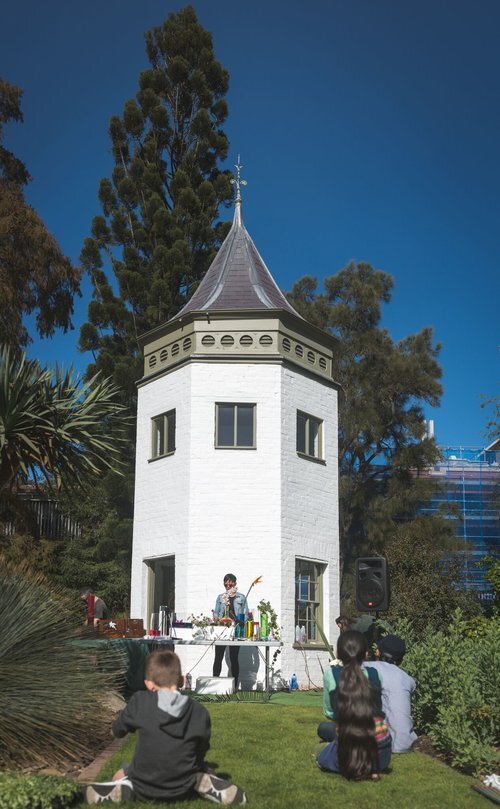
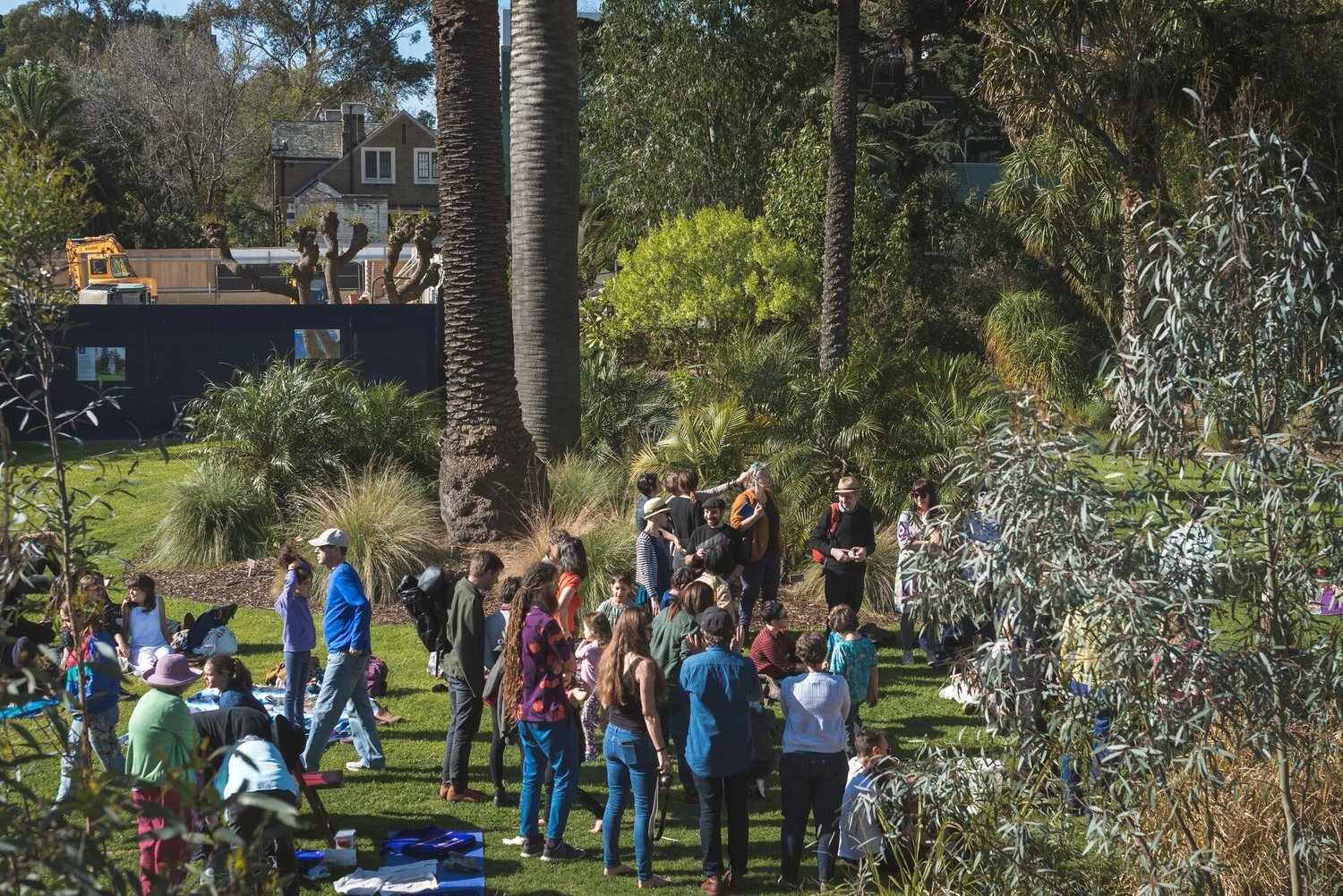
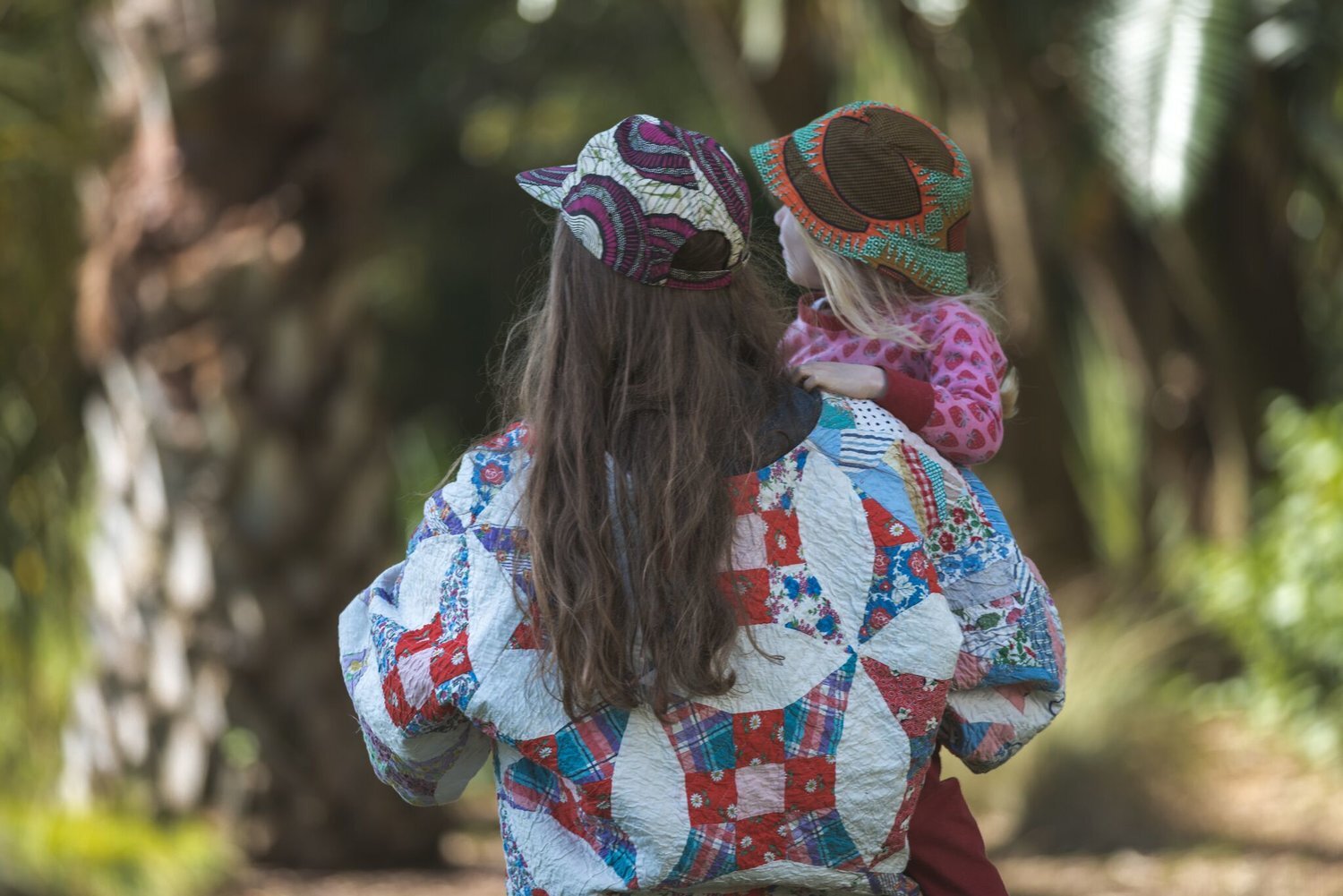
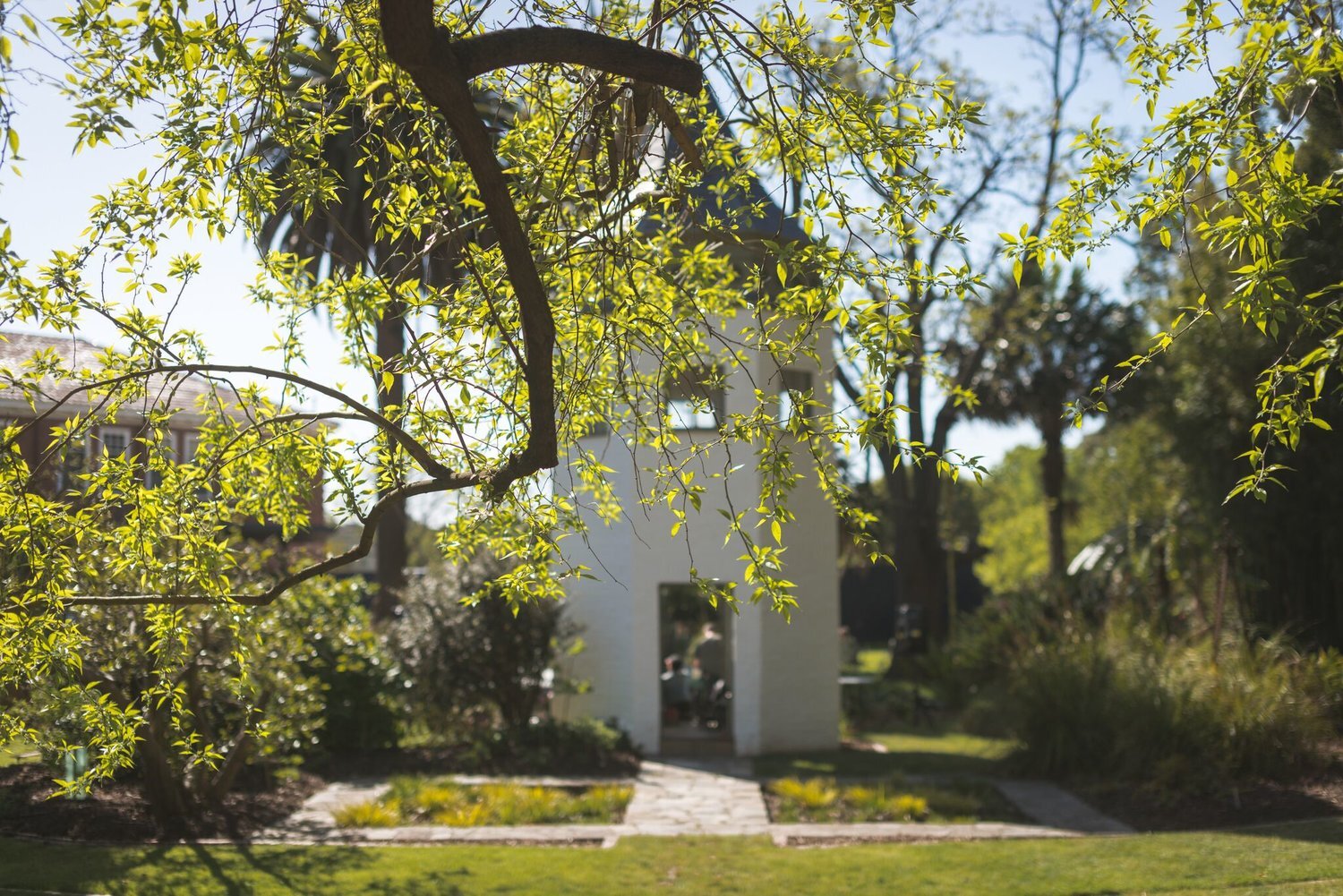


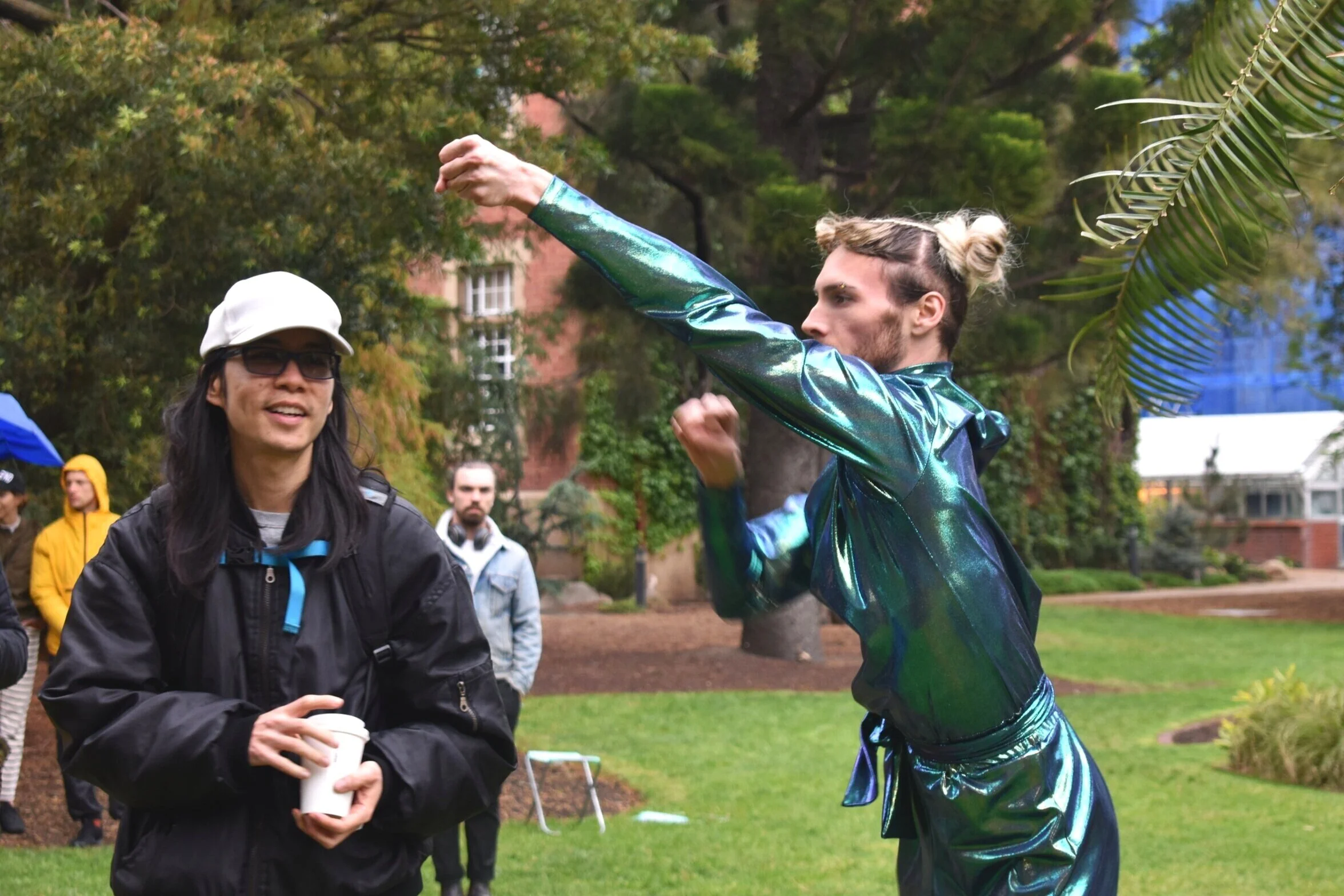




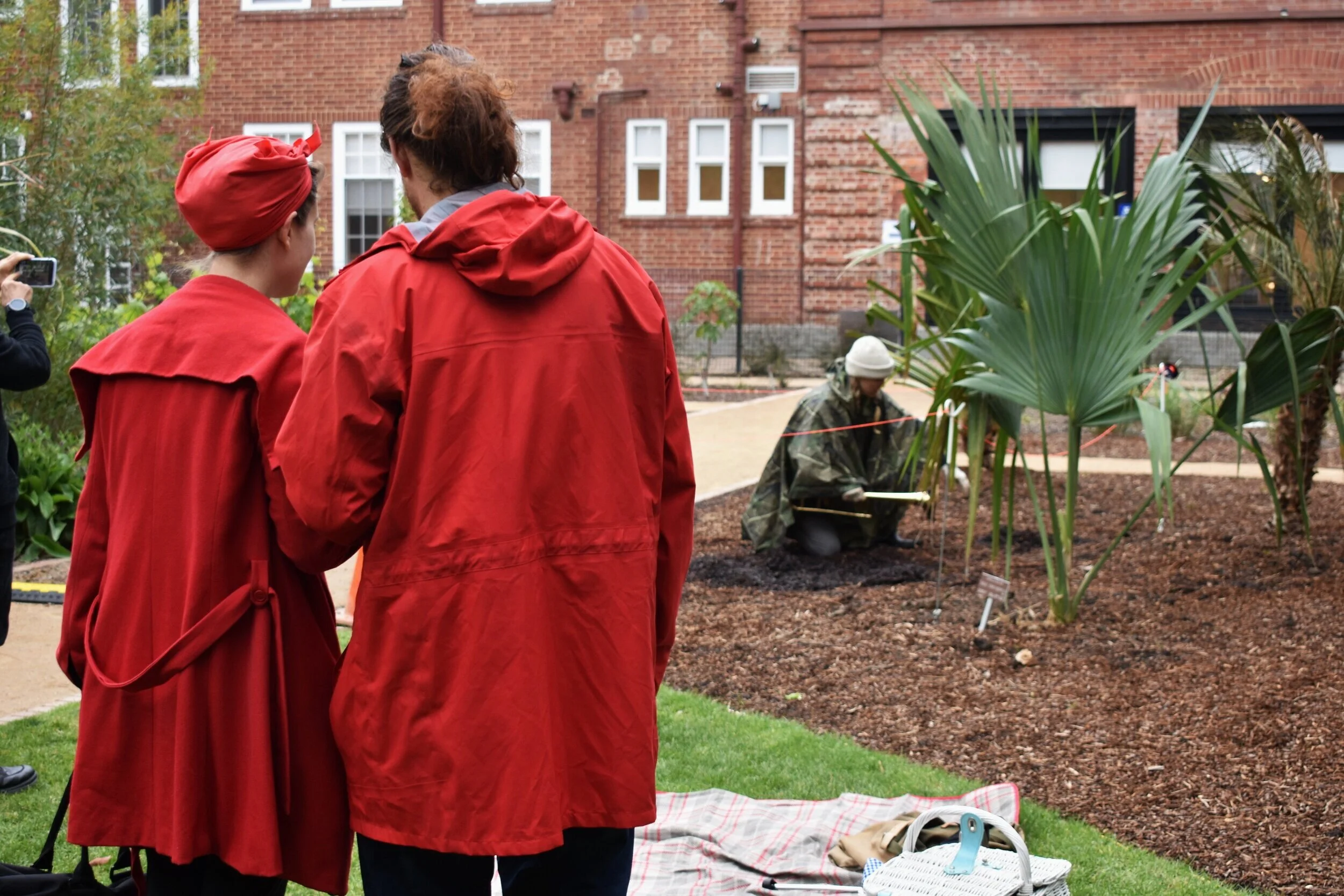
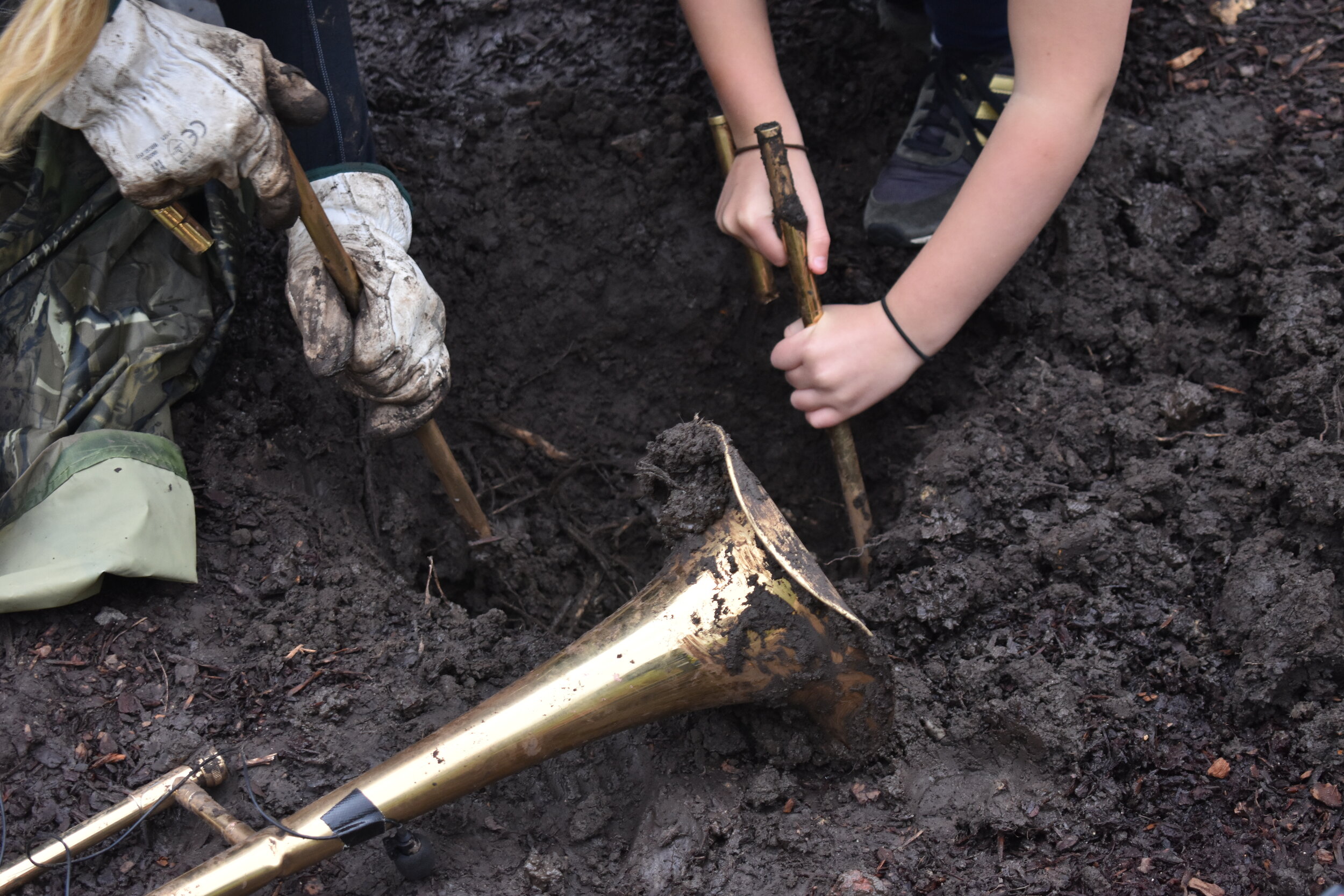

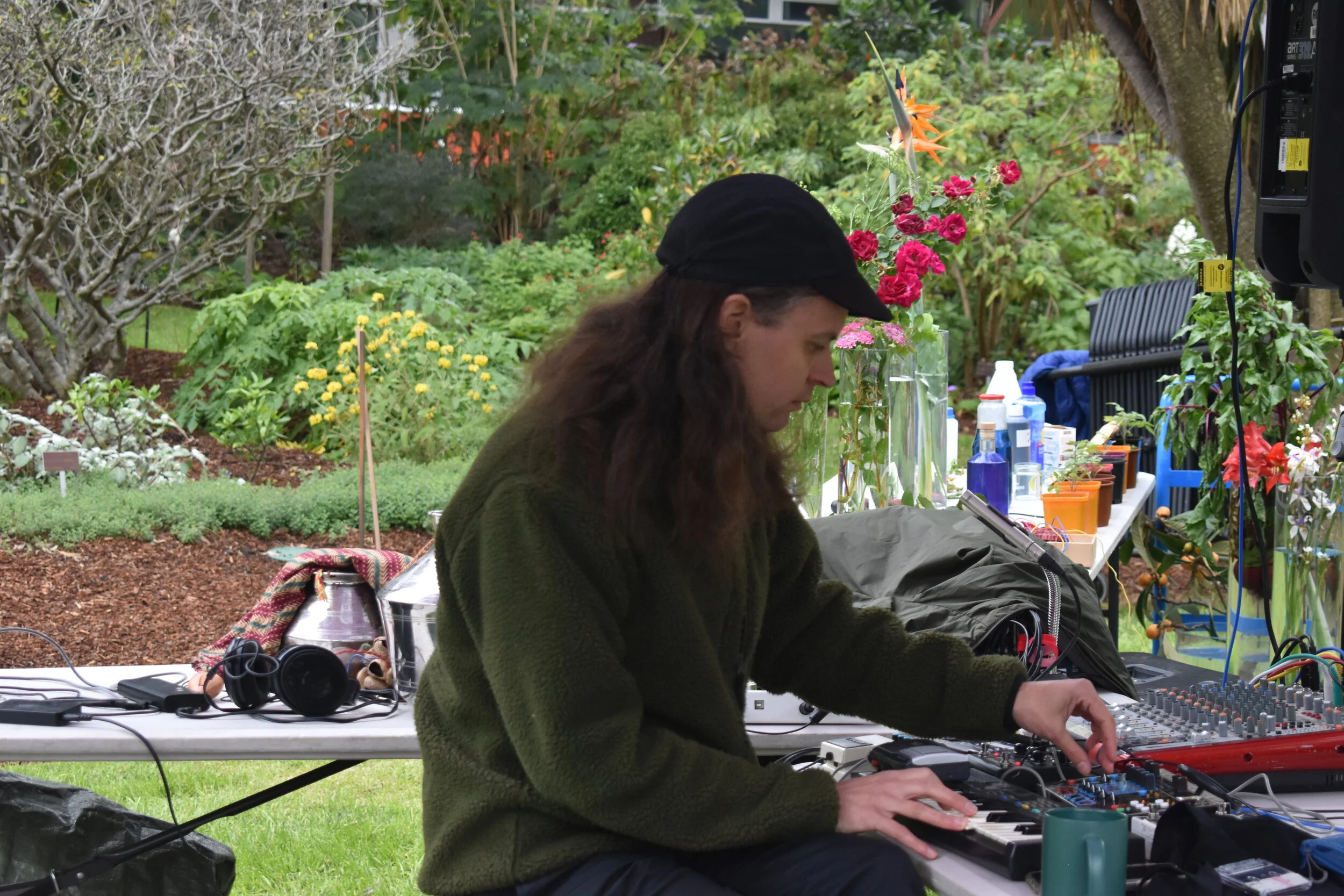
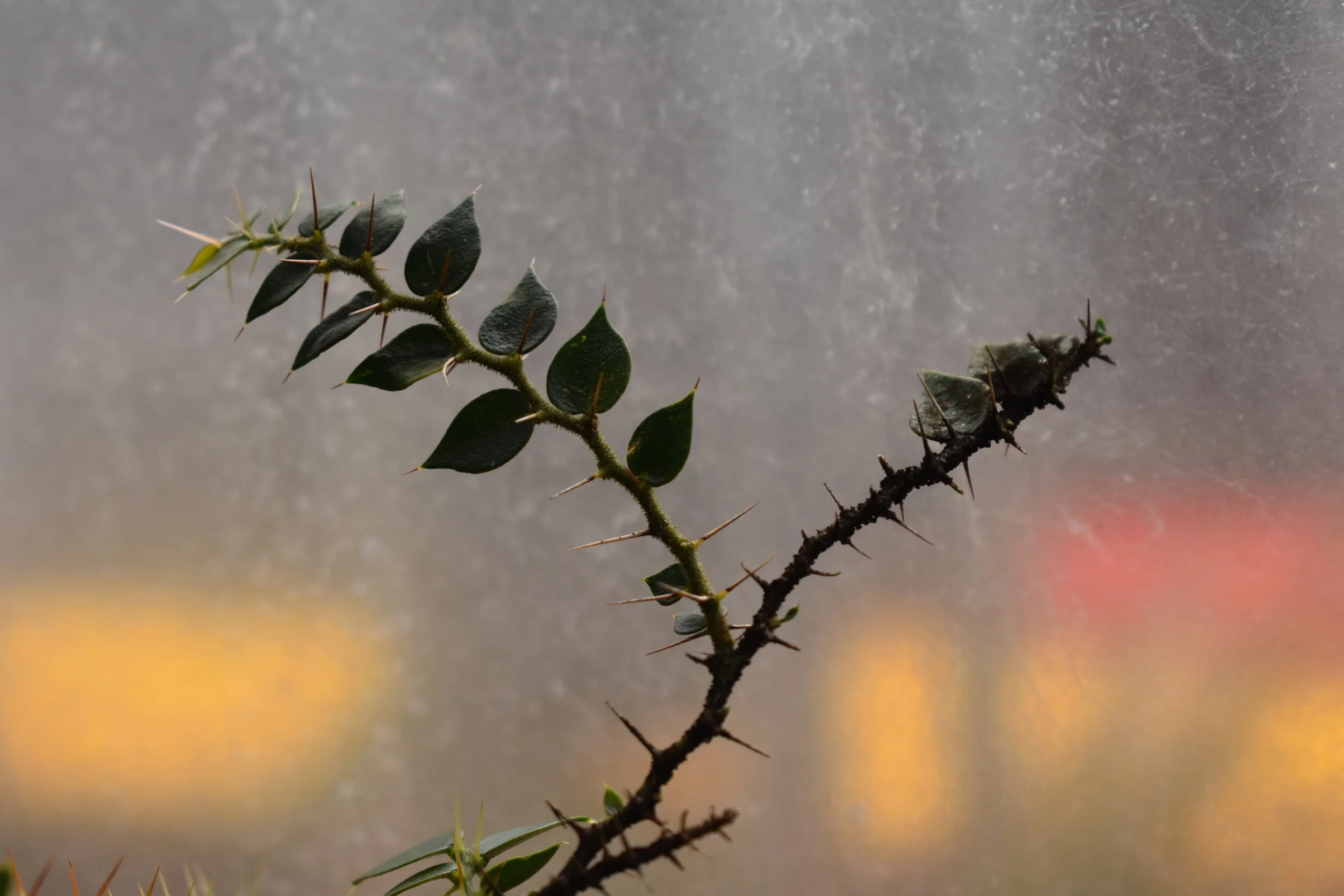


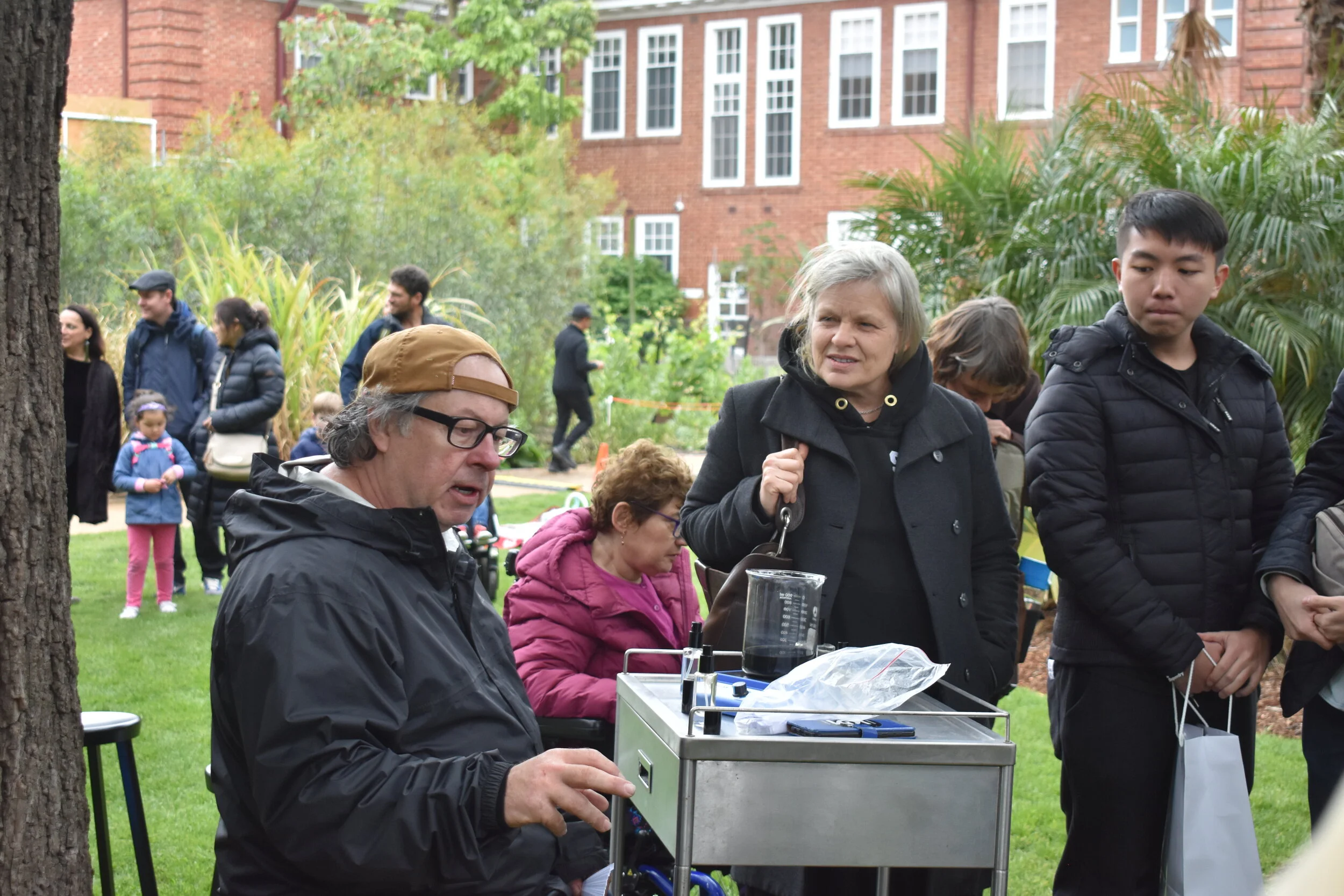
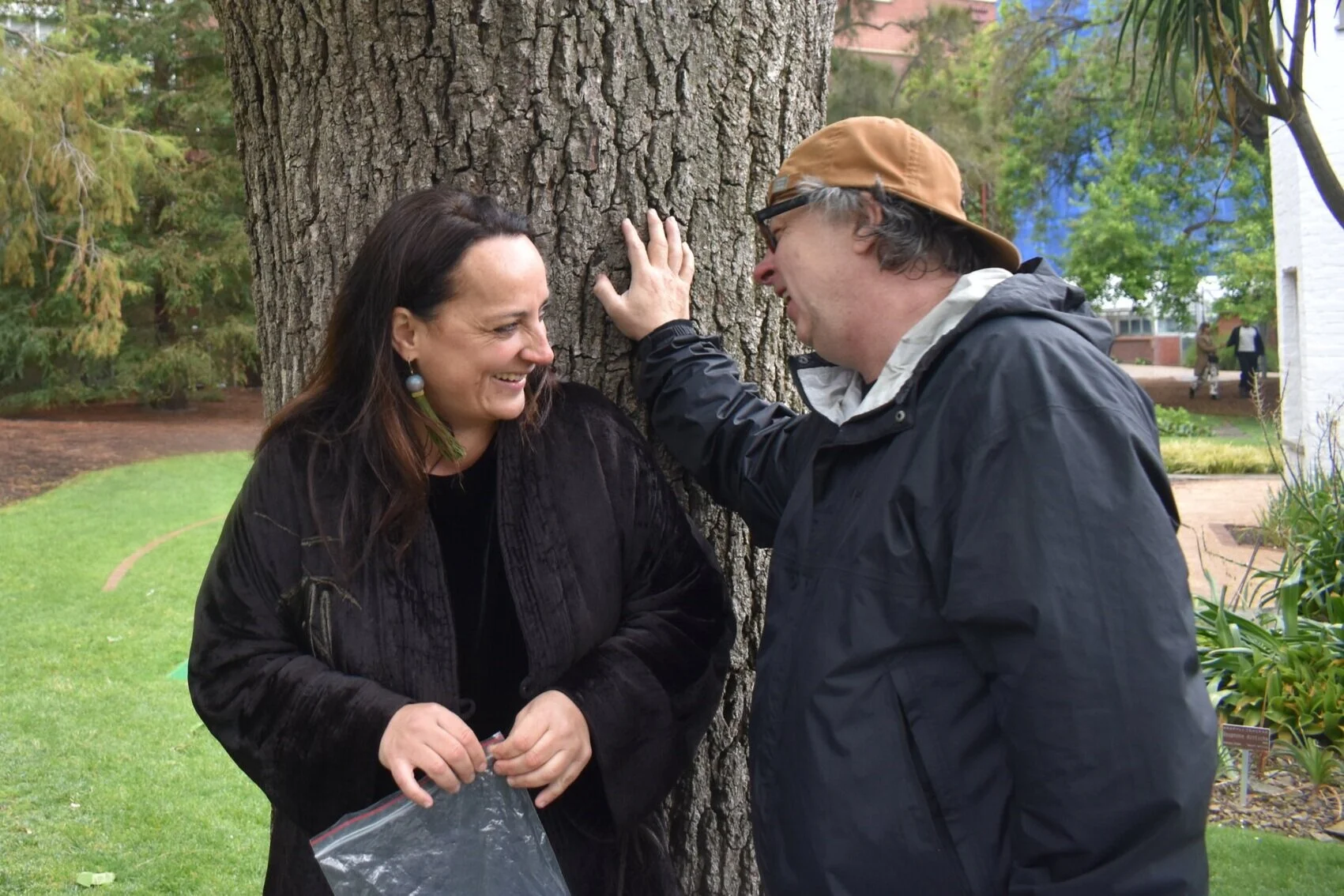

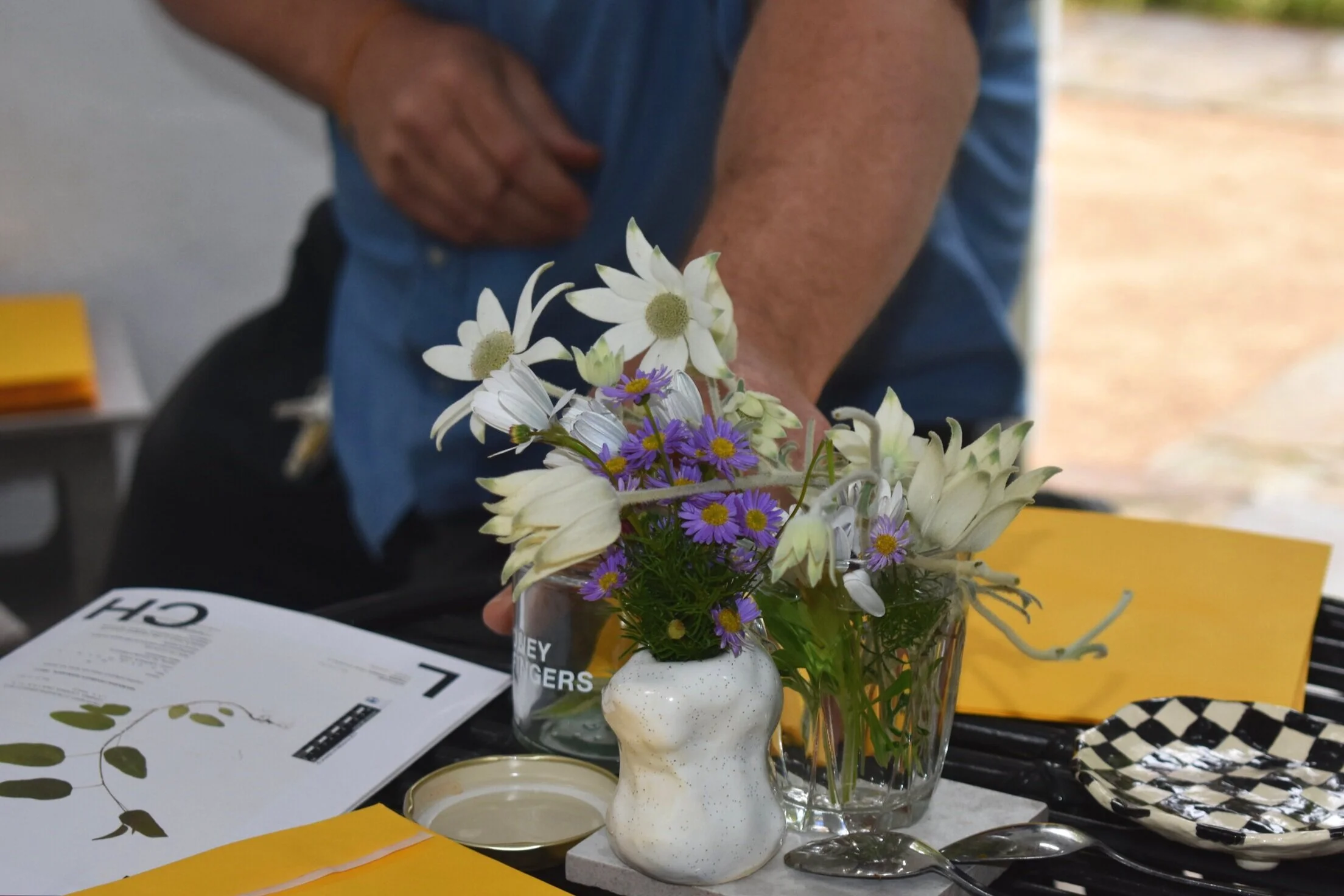












MULCH; a System Garden Performance Picnic
November 9, 2019
Performance chemist and curator Lichen Kelp brought together an eclectic range of artists for an afternoon of live art and sonic performance in the University of Melbourne System Garden – an oasis in the heart of the Parkville campus.
David Haines, Loren Kronemyer (Pony Express), Lisa Lerkenfeldt, Tim Coster, Honeyfingers (Nic Dowse), Kelp D and Benjamin Hancock presented a series of site-specific works in conversation with the plants and local ecologies of the Garden. Chemical reactions, improvised movement, experimental electronics, beekeeping, poetry and perfumery all combined in a dynamic program of esoteric and scientific investigation.
The System Garden Picnic was presented by Forum of Sensory Motion as part of The Potter’s 2019 Inside Out program, generously supported by Peter Jopling AM QC, Andy Zhang and Calvin Huang.
Image; David Haines. Wollemi Kirlians (detail) courtesy of the artist and Sarah Cottier Gallery

Lisa Lerkenfeldt
Australian artist Lisa Lerkenfeldt’s multi-disciplinary work embraces music concrète, environmentalism, noise, found objects and the cinema of Marguerite Duras in the composition and imagining of her live post-digital, post-industrial landscapes. Concerned with intimacy and technology her performances and recordings employ feedback, electronics, objects and field recording to generate new experiences in sound and gesture.
Recent work:
29° on Longform Editions
https://longformeditions.bandcamp.com/track/29
Links:
https://soundcloud.com/lisa-lerkenfeldt
https://lisalerkenfeldt.bandcamp.com/releases
image by Xanthe Waite

Loren Kronemyer uses an antidisciplinary approach to create immersive alternate realities and interspecies performances. She is interested in queer ecologies, slow apocalypse, and cyclical time. As part of MULCH; System Garden Performance Picnic , Kronemyer presented a live performance working intimately with the living elements of the garden throughout the afternoon.
Loren is an internationally exhibiting artist from Los Angeles, California. After graduating with a BFA in New Genres from the San Francisco Art Institute, she joined the SymbioticA and obtained the first Masters of Biological Arts degree at the University of Western Australia, where she developed several forms of living and self-healing drawing. She collaborates frequently with laboratories, and is one half of the live art duo Pony Express. She is currently based in regional south eastern Tasmania, working on a PhD as an Australian Research Training Scholar at the University of Tasmania.

Nic Dowse is an architecture graduate and urban beekeeper, poet and artist working in and around Melbourne, Australia. He is the founder of the Honey Fingers Collective, an interdisciplinary and international network of beekeepers that explores the surprising intersections between honeybees and the many disciplines of HFC collaborators. Current collaborative projects include: the pollination of infill agriculture; human foods fermented with the microbial life of beehives; and the documentation of traditional beekeeping.

image: The Wollemi Kirlians by David Haines 2014 courtesy of the artist and Sarah Cottier Gallery.
For MULCH: Performance Picnic, David Haines will be creating a new series of Kirlian images based on the plants found in the System Garden along with a perfume synthesised from the native and exotic flower plantings.
http://www.haineshinterding.net/2014/09/04/the-wollemi-kirlians-2014/
http://www.haineshinterding.net/aroma-studio/
The following is a text written for the Kuandu Biennale extracted from a longer essay written by curator Jasmin Stephens…
David Haines is presenting an installation comprising a suite of images using the technique of Kirlian photography and a fragrance he composed in his Aroma Studio. In his sculptural assembly, Wollemi Kirlians (2014) and Slow Fast Mountains (earth aroma laboratory)(2014), Haines has configured the visual and olfactory elements to set up a recognition system intended to bring Biennale visitors into closer proximity to ‘unseen forces’ that lie within and around us. Haines’ installation exemplifies the tension between ‘the fictive and the phenomenal’ that lies at the heart of his enquiries. He is drawn to the ghostly qualities of Kirlian photography, a technique for creating contact prints by charging the air around an object, pioneered by Russian electrical engineer Semyon Kirlian and his wife Valentina in the mid-twentieth century. Haines’ photographs are of plants from the Wollemi Wilderness, a remote and mysterious region, that shelters the elusive Wollemi Pine, a species known only through fossil records until it was discovered in 1994. The photographs, with their connection to ‘spirit photography’, and the fragrance, which is suggestive of the damp earthy smell thrown up by the rain, are intended to evoke a range of associations – fantastical and grounded. Haines embraces his inability to contain the ‘live’ nature of his works. Fragrances, for example, are thermodynamic in their emanations, heading towards equilibrium in any environment and subject to entropy which is why they are refrigerated and stored in coloured glass to protect them from heat and light. Their ephemeral tendencies raise questions about where they start and finish. As they lodge in the mind as much as the body, any thoughts about ‘what’s inside and outside’ become out-moded and a re-organising of ‘space’ as a continuum within and beyond ourselves is required. For the Kuandu Biennale, Haines has arranged the installation so that there are many images and one smell. The asymmetrical layout is intended to loosen the correlation between what is seen and smelt and what is real and artificial. Visitors are able to ‘register’ the aroma in any number or combination of plants. Haines has not pursued an efficient linear flow between the installation components and viewers/smellers. Energies – physical and symbolic – that derive from the materiality of the works and the wealth of interpretations that surround their display, are mixed and re-transmitted in real-time in the gallery. Haines has a sustained commitment to not only the visible but also the audible and ‘smell-ible’ aspects of the frequency spectrum. The frequency spectrum is the system by which different types of energy generated by the fluctuations of the earth’s magnetic and electrical force fields are classified. Frequencies of molecular spin can be discerned as scent with the most notable example being ozone which is the smell before a thunderstorm due to burning ions. Haines regards these energy systems as integral to his processes and materials. In aligning himself with the them, he has asserted, ‘we are transmitters because in a bodily fashion, the receptors of our senses are highly attuned to sections of the spectrum and are converting energies into sensation .... the sensation field is a tuned system.’1/Abstracted from Jasmin STEPHENS’ essay

Kelp D with Benjamin Hancock
An electronic ikebana and beneficial insect performance by Lichen Kelp set to music by Dylan Martorell and improvised movement by Benjamin Hancock.
Image: Kelp D/J with Benjamin Hancock; Why Listen to Plants performance for Liquid Architecture, 2018. Photo by Keelan O’Hehir.
https://www.benjaminhancock.net/
Dylan Martorell/ https://www.slowartcollective.com/

Benjamin Hancock is a dancer and choreographer who has featured in works by many of Australia’s leading choreographers including Lucy Guerin, Lee Serle, Sue Healey, Prue Lang, Antony Hamilton, Martin del Amo, Narelle Benjamin, Melanie Lane and Gideon Obarzanek. As a solo performer, Benjamin has presented work for MONA Gallery, Prospect 3 New Orleans Biennale, Chunky Move, National Gallery of Victoria, and Lucy Guerin Inc. Benjamin received an Australian Dance Award, Green Room Award and Helpmann Award Nomination for Outstanding Male Dancer in Lucy Guerin Inc’s The Dark Chorus. Benjamin is also a current member of the multi awarding winning drag cabaret show YUMMY.
He has performed with Kelp D (with Lichen Kelp and Dylan Martorell) and Kelp D/J (also with Jason Hood) since 2017 and participated in the 2017 Forum of Sensory Motion residency in Kythira and Serifos, Greece and performed over two days of FSM events in Athens.
image: Benjamin Hancock performing with Kelp D/J at Testing Grounds for Forum of Sensory Motion’s outcomes from The FSM Greece 17 residency. Photo by Keelan O’Hehir.

This Picnic has grown out of an earlier Musical Picnic event held in 2017 at the System Garden, hosted by Dylan Martotrell (one half of Forum of Sensory Motion and Kelp D) for Ian Potter Museum
Image; Carmen Chan and Dylan Martorell performing as part of Kelp D at the System Garden 2017. Image by Keelan O’Hehir
More images here

The System Garden at Melbourne University is in a bit of a secret spot, hidden away near the Percy Grainger Museum- the closest main road is Royal Parade. If you haven’t been before, give yourself a bit of extra time to find it, but if you need directions they can be found here.
Image by Keelan O’Hehir

David Haines’ earth-based molecular perfumes based on the soil of the System Garden, featuring ingredients such as geosmin, pure beeswax and ambergris to create a dry and dusty but satisfyingly pleasant pre-petrichor aroma of a garden just before a rainstorm.

David Haines talking the audience through the fascinating process of creating perfumes based on the System Garden.

David Haines discussing scent; “There is evidence to suggest our noses are quantum tunnelling…” image by Lichen Kelp.

Honeyfingers; poetry reading and lemon myrtle tea ceremony. Nic Dowse - founder of community based urban beekeeping collective Honeyfingers published a small run of his poems based on flowers that are found local to the System Garden and included his own honey varieties as part of the tea ceremony. This honey was collected from hives around nearby Carlton that Nic oversees, with a high likelihood that the bees would have feasted on the exotic flowers from the University garden.

Lush and verdant video documentation by the lovely folk at Common State, courtesy of Ian Potter Museum of Art.
View it HERE